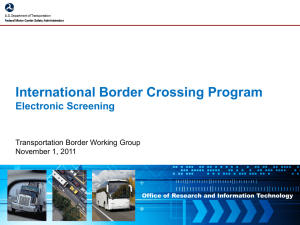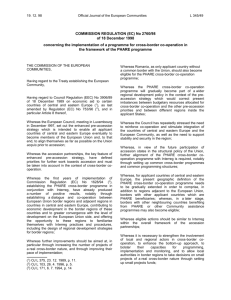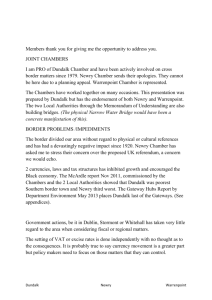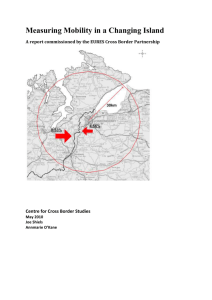Powerpoint Presentation 3.9mb - Co
advertisement
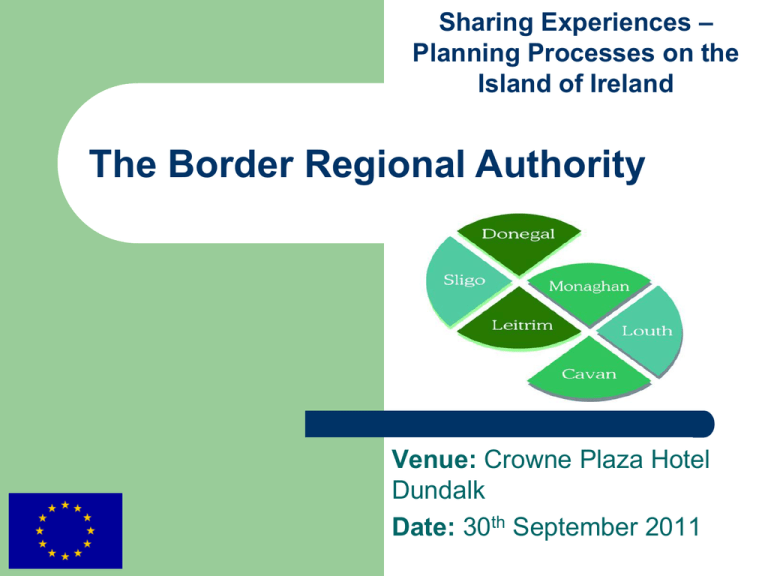
Sharing Experiences – Planning Processes on the Island of Ireland The Border Regional Authority Venue: Crowne Plaza Hotel Dundalk Date: 30th September 2011 Current Planning Policy on Island of Ireland N.I. Planning System Regional Development Strategy Planning Policy Statements Development Plans Supplementary Planning Guidance Irish Planning System Planning Reform Northern Ireland Planning Act (Northern Ireland) 2011 Sets the framework for the future of planning. It provides for the transfer of the majority of planning functions from the DOENI to Local Government (when) new governance arrangements for councils and a new ethical standards regime for Councillors will be put in place and at a time to be decided by the assembly; Majority of Planning functions transfer to local government – District Councils will be responsible for preparation of local development plans, determining majority of applications and taking enforcement actions Planning Act NI 2011- new amendments Local Development Plan 15 year Local Development Plan – will consist of two separate but related documents (Plan Strategy and a Local Policies Plan); New Development Plan timeframe – to be agreed between District Council and DOENI (no time limit however!); More effective participation from public and stakeholders earlier in plan process; Move away from objection based examination to ‘soundness’ approach. Planning inquiries will still be held but will be more thematic based rather than submission based; Greater potential for joint working between councils – providing joint plans between councils (Section 18) New Planning Act NI 2011- new amendments (cont.) Development Management 1.Create a positive development management culture; 2.3 Tiered Planning Application Structure – Regionally significant, Major and Local (very similar to Scottish model); 3.District Councils will process some major and all local planning applications. DOENI will process regionally significant applications through direct submission or through call-in; 4.Early pre-application discussions will be mandatory, especially with respect to larger planning applications; 5.Continuation of current streamlined planning applications process – faster processing of smaller/more minor planning applications; Planning Act NI 2011- new amendments (cont.) Enforcement Period in which enforcement action can be taken changed to 5 years (previously 4yrs for operational development and 10yrs for CoU); Introduction of fixed penalty notices for failure to comply with enforcement or breach of condition notices Multiple fees for retrospective planning applications Planning Appeals Period within which appeals may be made have been reduced from 6 – 4 months – could be reduced further to 2 months later; Appeals to be decided exclusively on material that was in front of the authority when decision was made on planning application; Irelands Planning & Development (Amendment) Act – 2010 Background & reasons for the 2010 Act There are now around 440 Development plans and LAP’s Co-ordination can be difficult with so many plans; Implications of new EU Directives are significant for planning; Lack of co-ordination between regional and local plans led to a series of Ministerial Directions; Previous RPG’s were vague with little impact on planning; Experience of last 10 years pointed towards the need for reform in relation to legal and technical requirements regarding integration and coordination of national, regional and local plans; More evidenced based planning was therefore required; Planning & Development (Amendment) Act – 2010 cont. Development Plan •Enhanced role for Regional Authorities in Plan Process •New provisions to better integrate SEA and AA processes into Development Plan reviews •Need for a Core Strategy as introduced by Section 7 of the 2010 Act •Purpose: to demonstrate that the development plan and its objectives are consistent with the National Spatial Strategy and Regional Planning Guidelines… •Consistency: as regards (1) role and function of a Hierarchy of Gateways, Hub Towns, county towns, other towns and villages and rural areas and (2) allocations of population and land for housing to give effect to the hierarchy above… •Timing: To be in place within 1 year of adoption of 2010 Regional Planning Guidelines, by variation of Development Plans if necessary… •Content: • (1) Core Strategy section of Written Statement… • (2) Core Strategy Table… • (3) Core Strategy Map… Planning & Development (Amendment) Act – 2010 cont. Development Management 1.EIA and retention of developments – ECJ Ruling C-215/06; 2.Quarries - new registration process. This part has recently been enacted; 3.Material Contraventions under Section 36 of the Act now applied to LAPs; 4.Extension of Time on Planning Permissions – However, there is strict criteria laid out in the Act Enforcement 1.Planning Authority may refuse planning permission based on applicants track record; 2.Fines have been increased for various offences Criticisms of our Planning Systems It creates delays, uncertainties & unnecessary costs It does not provide sufficient direction to land use and property development activities It does not provide an appropriate balance between social, economic and environmental factors Planning simply regulates development and is not responsive to change or facilitating new development It is too cumbersome and complicated It creates uncertainties and inconsistencies for all stakeholders involved in the process It is not in the public interest – it favours vested interests It favours the rich and elite in society Similarities and Differences between Planning Systems on this Island Similarities Level of interest in planning Challenges in planning Increasing regulatory context (EU Level- Directives) Transboundary issues Requirement for proof of alignment between planning documents Structured Departmental Guidance Documents (PPS in NI & Section 28 Guidance in ROI) Differences Reserved/Executive Functions Time limits – Development Plans and Planning Applications; Third party appeals; Planning appeal periods; Addressing Change!! “An intelligent fool can make things bigger, more complex, and more violent. It takes a touch of genius - and a lot of courage - to move in the opposite direction” ` Albert Einstein. Evidence of Change 1. 2. 3. 4. 5. 6. Perception of planning is changing – there is a cultural change in the mindset of people – was the Celtic tiger good for society?; Forward Planning is increasingly evolving and providing greater strategic direction at all levels of plans (Top/Down & Bottom/up) More data and information is available to support plans (greater evidence base) – GIS and technological improvements; There is recognition of the need to link the provision of infrastructure and land use planning – particularly at the strategic planning level; Planning is now seen as central to pulling together all sectors of society to provide services in an efficient and effective way i.e. health, education, transport etc.; There are stronger links between spatial plans, particularly in Ireland and with the new amendments to the planning code introduced through the P & D (Amendment) Act 2010 Evidenced Based Planning Source: Strategic Investment Board, 2009 Co-operation – How are we doing? A lot done – more to do! • Spatial Strategies on the Island of Ireland – Development Framework for Collaborative Action; • North West Gateway Strategy; • Newry / Dundalk Twin City Strategy; • Memorandum of Understanding between Newry and Mourne DC and Louth County Council • Independent Research such as ICLRDs Publication on Fostering Mutual Benefits in Cross Border Areas The potential of the existing Interreg Projects in the ICBAN Region (Spatial Planning Initiative) and in the North West (SPACEial) are significant and will contribute and shape future statutory plans Potential for Collaboration and Co-operation – National level Spatial Framework for Collaboration (cont.) Spatial Challenges Settlement patterns & population growth Housing Economy Environment Climate Change Connectivity Electricity Priority Areas 1. Equipping the Island 2. Competitive Places 3. Environmental Quality 4. Spatial Analysis Areas for Co-operation at Regional/Local Level 1. 2. 3. 4. 5. 6. 7. 8. Planning – Need for improved consultation on Development Plan Reviews. New protocol/procedures required for referrals on appropriate planning applications (inter-jurisdictional & transboundary); Joint Plans for Settlements/Areas - Amendments to both planning codes permit this (Clause 17/18 in NI 2011 Act) (Section 18 (2) P & D Act) – Cross Border?? Landscape – Classification and characterisation of landscape is significantly important to plan making – it however needs to be carried out using the same methodology; Retailing – Significant cross border issue and definition of catchment populations; Housing - New Housing Market Assessment programme in Northern Ireland will be first to look at housing market areas in a cross border context (current 3 year programme) Water Services - Towns and villages designated for growth in Development Plans along the border could be serviced by the other state! Environment Services – Natural catchments & RBMPs Implementation is important. . Waste Management is administered over different regions – currently a cross border issue Pooling Specialist Resources - LAs and District Councils have less staff and greater demands on resources. Specialised services and information could be shared in areas such as – flood risk assessment, SEA& Habitats Assessment; Potential for Co-operation - Sectoral Opportunities Renewable Energy & Environmental Products and Services Transport Sustainable Tourism Health Education Housing Agri-food Sector Waste Management Conclusions We have two Planning Systems that are changing & evolving - need for improved implementation & co-ordination at national level down to local level; In a tighter fiscal environment, there are cost efficiencies and potential for more effective delivery of services in all sectors through improved collaboration and cooperation – planning included! There is a gradual change in cultural mind set towards planning which must be harnessed; Co-operation and collaboration adds value – why do we not do more of it?; Co-operation requires leadership – from both officials and members; The Collaborative Framework provides a key tool for both Governments, Council Officials and Members to develop plans and strategies in identified sectoral areas to enhance our quality of life on this island Thank you for listening Padraig Maguire Regional Planner for Border Regional Authority www.border.ie padraigmaguire@border.ie 0494362600





